Freight shipments across all modes of transportation dropped the most since Nov 2009.
Freight shipment volume in the US dropped 6.0% in May compared to May last year, the sixth month in a row of year-over-year declines, and the sharpest year-over-year drop since November 2009, according to the Cass Freight Index for Shipments.
The index tracks shipments of goods for consumer and industrial sectors across all modes of transportation – truck, rail, air, and barge. But it doesn’t track shipments of bulk commodities, such as grains. This chart shows the changes in percent of shipment volume for each month compared to the same month a year earlier:
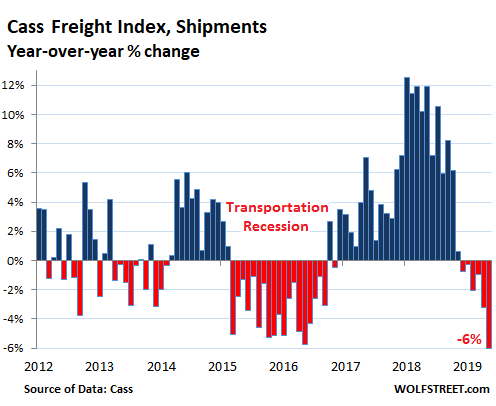
Similarly, the Association of American Railroads (AAR) reported that in May overall freight rail volume fell 4.1% from a year ago. The segment of intermodal freight volume – such as containers hauled by truck and then transferred to rail, or semi-truck trailers that piggyback on special rail cars – dropped 5.9%.
This adds industry-wide data to the cacophony emanating from earnings reports by trucking companies and railroads – including J.B. Hunt, YRC Worldwide, and BNSF Railway: Shipment volumes are declining, but companies are trying to maintain their revenues by hiking freight rates, and now freight rates that had skyrocketed last year have also come under pressure.
But the comparisons are with the phenomenal outlier-boom-year that was 2018 for the transportation sector, and particularly with May 2018, which had been the peak of that shipments boom. Just how big was last year’s boom in shipments?
In the stacked chart below of the Cass Freight Index for shipments, the top black line delineates the shipping boom in 2018 that then faded in the second half and turned negative year-over-year in December 2018 (black line drops below green line). The index for 2019 (red line), while below 2018, remains solidly above 2017 and all prior years:
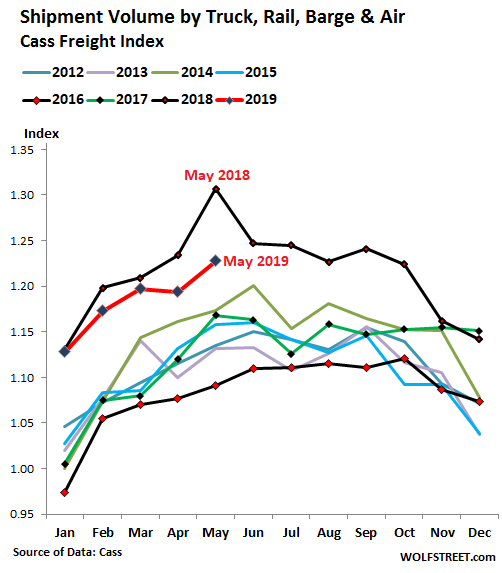
In late 2017 and through summer of 2018, freight rates had been driven up by a capacity crunch in the trucking industry, and a panic amid shippers – such as big retailers or industrial companies that need to get their merchandise across the country – that trucking companies won’t be able to keep up with demand.
To meet that demand, truckers went on a buying binge, ordering a record number of Class-8 trucks that now have entered service. And suddenly, the market is oversupplied with capacity, orders for Class-8 trucks collapsed by 71% in May compared to May last year, and freight rates are falling.
But there is a glaring duality in the market. DAT Solutions, the largest truckload freight marketplace in the US, reported that average contract rates for dry vans have fallen 6.7% in May from their peak last July, and 2.6% year-over-year, to $2.23 a mile. Contract rates mostly apply to larger trucking companies with large clients with which they have long-term contracts.
In a big blow to smaller truckers that rely on the spot market for loads: Average spot rates, according to DAT, have plunged 17% year-over-year and 23% from the peak in June to $1.79 a mile. These spot rates put smaller trucking companies into a squeeze. As Craig Fuller, CEO at FreightWaves, wrote in an editorial about the duality currently in the market: “Many fleets are just fighting for survival.”
The Cass Freight Index for Expenditures is starting to show this trend. The index tracks spending by shippers, such as retailers or industrial companies, on all modes of transportation – truck, rail, air, and barge – and includes fuel surcharges. It reflects the total amount spent by shippers on freight. The underlying data is based on $28 billion in freight transactions that Cass processes annually for its clients – major shippers in consumer packaged goods, food, automotive, chemical, OEM, retail, and heavy equipment.
The Cass Expenditures index had peaked last September with a 19% year-over-year surge. From that point on, the year-over-year gains backed off, and in May, it showed its first year-over-year decline:
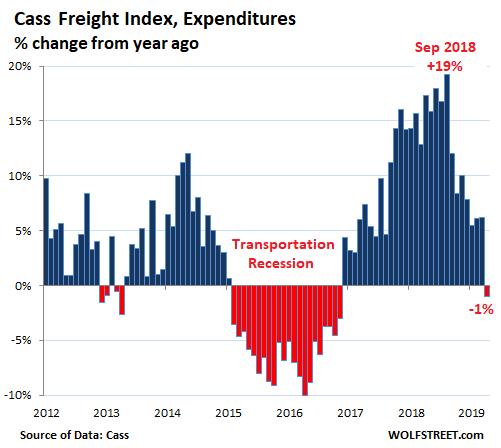
Drilling down into some of the details: The Cass Intermodal Price Index, which tracks pricing of domestic intermodal freight (via truck and rail), had reached a year-over-year gain of 12% last July. Prices continued to rise but at slower rates, peaking in March. In April and May they fell on a monthly basis, with the index retracing to where it first had been in October 2018.
“With the severity of weakness in truckload spot pricing, [the price boom] has finally come to an end,” Cass reports for May. With those two monthly declines in a row, the index in May was still up 4.2% from May last year:
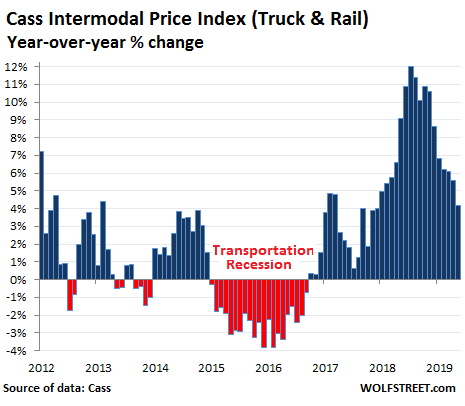
Full-truckload pricing has now declined in all but one months this year, according to the Cass Truckload Linehaul Index, which tracks per-mile full-truckload pricing and does not include fuel or fuel surcharges. The index is down 6% from its peak in December, wiping out most of the large gains last year, and whittling down the year-over-year gain in May to just 1.2%.
Cass points out: “While still notable given the increasingly difficult comparisons [with the boom in the first half of 2018], it also suggests that the weakness in spot pricing is having a material effect”:
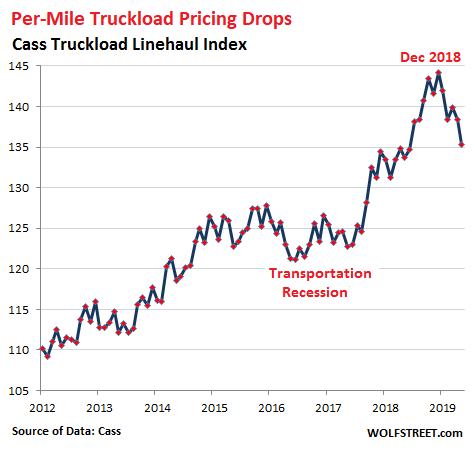
This is how the blistering boom in the transportation sector last year through the summer is now unwinding. The industry is very cyclical. But the declines in shipment volume in 2019 so far are from that blistering boom that resulted from companies piling on record inventories to front-run potential tariffs. This strategy appears to have run its course, and a different sense of reality is settling on the industry.
Orders for Class-8 trucks plunged by 71% in May year-over-year, the weakest month of May since 2009.” Read… What Collapsing Orders for Heavy Trucks – Down 71% from a Year Ago – Say about the U-Turn in Trucking
Enjoy reading WOLF STREET and want to support it? You can donate. I appreciate it immensely. Click on the mug to find out how:
![]()


So if this freight decline is bigger than the one a few years ago that almost caused a recession, will the pressure on the Fed to cut be too much? Never mind ultra low rates have completely failed to prevent doowrurns let alone improve it’s economy in Europe…Those Who Never Learn will never learn.
Timbers: it still looks like 2019 might be the second best year in the last five or so years.
Comparing everything to 2018 will of course make everything look bad.
Try comparing 2019 with pre 2018 years and the picture changes!
Not sure if truckers would like to go back to pre 2018 years at lower levels.
Truckers have to be tough to survive!
I,m also convinced, vendors and freight companies “fudge” their books, in an attempt to keep rates down. Naturally it,s the truckers who pay for this! For many years the trucking industry has had the narrowest of profit-margins, of any industry . Why should it change now?
Recessions in credit cycles have nothing to do with PMI’s or a few Billions in tariffs… The crisis brewing is in Offshore Interbank or Eurodollar Markets, check futures at CME to see the Call-Put ratio, it’s extremely bearish July on, either way tide goes, with amount of volume dumped recently, losing side is fucked on top of tightness, too much fake liabilities, credit got out of hand real bad with ZIRP in Major economies. Add derivatives to the mix, forget about it!
Rate Cuts and QE have nothing to do with economy in this cycle, it’s about the credit bubble. Fed isn’t even capable of stopping it, it’s offshore and off their jurisdiction, that’s why they are scared. They will just extend credit swap lines like in 08 to major CB’s for US Dollars, but as far as stopping it, they can’t. They can only react, whatever is gonna happen, is gonna happen, as far as the banking crisis of 2019 goes. Once certain banks go bust, ECB will take US dollar swaps from Fed, payout derivatives blow up, buy out bad loans and repeat early 2009, little mark to market wizardry and voila! Banking 101… How to get insanely rich by abusing then creating panic, in a system you designed.
Lemko you are a very bright person, wish I understood this a bit better, thanks for sharing, Bill
What about the hotshot market? I have been interested in owning a hotshot business. Good or bad idea?
Freight waves is a great source of inside trucking industry info. Free. They have a good finger on the pulse of the industry. Sometimes the writers can be a little of base but 90 pct of the time they know what is going on. Great job combining the freight industry in this article WOLF
Anecdotal.
Trucking slow down.
I have a friend who owns a heavy haul rig, eight axles with attachable jeep, hauling dozers, graders, etc. He is an independent operator who searches for his carry contracts on load boards, in close conjunction with a factoring firm.
Since late last year his loads have been re-possessions, end of rental contracts, rebuilds, used equipment sales (auctions), forced returns, etc.
But no new equipment deliveries. He says the secondary market has now become quite slow , as he must spend more and more time searching the load boards. And the freight brokers keep “low balling” him (offering less money), then he was receiving for the same loads last year. Meanwhile his payments and overhead expenses stay the same or even rise, as is the case with price of diesel fuel, or a late payment.
Tougher times coming.
I service the home improvement industry, the stores start to re stock after memorial day and that hasn’t happened this year. Some stores still have overflow merchandise that they haven’t sold yet. Because I’m not getting those restocking runs I’ve had to cut back on my spending plans. I’m still working but my order book and rates are way down.
I think we need to look at this as 12 to 24 month moving averages because large buying decisions like this are not made on the spur of the moment.
Remember, too, that a big part of the Class 8 buying had to do with the tax plan, and the ability to accelerate depreciation (in the same year as the purchase) for all truck orders.
So what is the synopsis on all of this? I’m currently in CDL School I should be driving by October or November. Should I be worried that I’m making a bad career choice?
Daniel,
This industry is very cyclical, as you can see from the charts, so that’s the first thing you need to get used to.
The second thing is, this industry is crucial to the US economy, so there will always be a need for transporting goods, even during downturns. But the money will vary. Make hay while the sun shines, and save some for rainy days.
I have no idea if and when self-driving features will replace human drivers, if ever, but in terms of long-term, that’s something to keep an eye on.
My gut feeling is, you’ll be fine. There is always a need for good drivers.
We have some active industry insiders here among the readers and commenters — drivers, owners of trucking companies, brokers, etc. Maybe they can weigh in on your question.
I will answer this for Daniel. The self driving truck wont be here for awhile. As far as job security you are set for a long time, industry always will need good drivers. . Trucking is a hard job and I think there are as many people leaving as there are coming to the industry. My advice to you is get your experience starting with the dry van, don’t do reefer work unless it’s drop and hook work. You will not make much due to long load/unload times. Once you get your experience move to flatbed work. Its a little dirtier, but very easy as far as load/unload times and receivers actually happy to see you when you show up.
Has anyone thought about potential liability for self driving systems? Or what insurance might cost for trucks so equipped?
All I see on the tube is ads offering help to claim big money for your malady caused by using…… -fill in the blank here- .
The self driving truck will become a reality. It just won’t appear on public roadways. The railroad has had self driving trains for decades and yet they have found out through studies and their own experiences that for a safety factor that would be accepted by the public there MUST be 2 sets of human eyeballs riding in the cab of their train locomotives. They already know what happens when there’s not enough humans in the cab. Trains crash and people die and property is destroyed and all of that costs LOTS of money. Anyway use a little logical thinking about your prediction of a self driving truck, fully loaded and running at speed down the interstate right next to mom and dad with the kids in the family car in the next lane over you say???? I say YOU’RE dreaming and nobody alive today will ever see that on one or any of our interstate freeways. Oh technically it can be done. But realistically and in the name of safety it won’t be done.
Silverado,
” and yet they have found out through studies and their own experiences that for a safety factor that would be accepted by the public there MUST be 2 sets of human eyeballs riding in the cab of their train locomotives”
I’ve been on self-driving subways. There was not even a conductor on board. No employee at all. Worked fine. I rode this train for the first time 10 years ago. But these things have been around longer. I just don’t travel that much anymore.
Your “2 sets of eyeballs” doesn’t even apply at our antediluvian BART system here in San Francisco. Just one set of eyeballs does the job, for 500 passengers. And these beaten-up trains have been on the track for 40 years or so.
Wolf, I’m not talking about a relatively small, closed loop, passenger hauling, subway train. I’m talking about class 1 railroads that haul freight cross country on huge railway systems. For instance remember the oil train that rolled away after being parked on a slight downhill slope in eastern Canada by a single employee at the end of his shift a few years ago??? Remember what those runaway oil tank cars full of oil did to that town Wolf?? And how many people died because of what that single employee did or didn’t do like set the parking brake??? That’s why the railroads, the class 1’s anyway, will NEVER go to driverless trains. NEVER!!! Too bad you didn’t put a reply button on your response as I’d LOVE to comment further. But I’m tired as it’s getting late so I’ll check this thread tomorrow…
Silverado,
Last year, Rio Tinto launched its fully automated rail network in Australia:
“A series of mine-to-port trains able to run completely free from human intervention. These AutoHaul trains travel an approximately 800-kilometer return journey, taking 40 hours to complete, including loading and dumping their cargo. The rail network is set up in the Pilbara region of Western Australia.”
“This is a world first,” a spokesperson for Rio Tinto told Digital Trends. “It is the first fully autonomous, long-distance, heavy-haul rail network in the world. The successful deployment is the culmination of a $940 million project and has the potential to transform the productivity and flexibility of the 1,700-kilometer network between our 16 iron ore mines and two ports.”
https://www.digitaltrends.com/cool-tech/robot-train-australia/
You will be fine.
Show up willing to work & learn…..your gold.
Midwest, rural, heavy ag area, might be tough for awhile
but we will rebound.
I don’t follow a lot of news or sites….over 45 yrs in the field,
I have never witnessed these weather conditions. Cold & wet with no end in sight. Better stock the cupboards…its gonna get expensive.
Been there, done that.
Not a Mormon, but believe their all-cause hunger insurance is sound.
Got a year’s worth of freeze-dried, hermetically packed vittles in home storage.
I know nothing about trucking, but if I were just starting out I would talk to those guys who do oversized loads. That segment may never get replaced by robots.
100% bad idea getaway on trucking job especially if you got family but if you single no bills you can stay but be ready for BS
“In late 2017 and through summer of 2018, freight rates had been driven up by a capacity crunch in the trucking industry” I work in the newspaper industry, and boy do I remember this. A couple of contributing factors were the hurricanes in late 2017, which I was told were sucking all kinds of trucking south for disaster recovery and rebuilding (during the holiday season, no less), and then the e-logging regulation going into effect (Jan 2018, I think), which I was told convinced many independents to switch from long haul to local hauling. Mills were paying an arm and a leg plus the other leg to get paper out, and passing the cost on to us. Looks like that’s died down now, and we’re finally seeing some relief in newsprint pricing.
Yesterday, I passed the billboard still advertising for log truck drivers. The job: 4 days on, 4 off. 12 hours per day with OT. 100K + per year, plus full benefits. Nice new equipment. Western Forest Products, Vancouver Island. It’s hard on the body though, all that banging around. The spurs up to the settings are narrow and made of shot rock. It takes a good 1/2 hour to load so there is lots of time for a stretch and coffee. On the mainlines they motor as fast as they can.
Canadian dollars are not American dollars so that 100K+ in Canadian dollars as you would be working in Canada isn’t going to go as far back home especially if you have to exchange those “Loonies” for US dollars. Anyway, you first. And let us know how that money exchange is going….
Once again an article late to the party. Any carrier with a low number of rigs have realized that the freight market is in trouble. Best article I’ve read was in reference to way 2018 was so good revenue wise. Tariffs! Shippers and receiver’s new they where coming and ran there quantities of product up ahead of the increases. An example of where the rates have gone is the load I’m on right now almost the same week last year paid $1500 this week $1100. Try to budget that and there’s ten trucks behind me willing to do it for less. Hang in there folks I believe we are still working our way to the bottom of this market. Good luck everyone. He will provide, Amen.
“Once again an article late to the party.”
Just because you didn’t read the articles here about the turnaround in trucking, starting last fall, doesn’t mean I didn’t write them. I track this on a monthly basis.
I, a simple 4-wheeler, have alot of respect for you guys. You work hard, take financial risks I avoid, and then there’s my personal experience:
Some years ago, my wife was driving an old 1972 Dodge Dart from Detroit to West Virginia and the radiator started steaming. She stopped and an 18-wheeler pulled up behind her. The driver got out and climbed down a bank to fill a jug with water, poured it in the radiator and both went on their separate ways.
Years later, I drove down a country road here to look at something I wanted to buy. There was a woman with a baby standing next to her car as I entered the road and she was still there when I returned, so I stopped and asked her if she needed help.
She said her husband is a trucker, our car just quit, he’s on the road and I’m stuck anyway – there’s no phone nearby (this was well before cell phones).
So I drove her and the baby to a phone booth down the road where she was to call her husband’s mechanic, but she had no money!
I had plenty of change (usually I don’t have any, but this time I had been on a buying trip), so I gave her the coins she needed.
Before she got out of the car, she looked at me – scared – and said: “You wouldn’t drive off and steal my baby, would you?”
I assured her that, with five kids at home, I didn’t need another and that, anyway, I owed a trucker a return favor.
Fed will cut tomorrow. Greenspan used to look at this trucking data … probably his biggest secret!
Since Sep 2018 peak Cass Freight Index fell 20%.
A sharp drop like that is recessionary.
When things don’t move, the economy is out of steam.
The DJ Transport was doing great since March 2003(L) til Sept 2018.
But the 16 years bull run is out of fuel in the tank.
The SPX is 1% from making another all time high, but if the Transport don’t confirm it, it means nothing.
Today wall street had a good day, but the bond market didn’t care. When interest rates fall and the transport stall, something is very wrong
with the global economy.
I’m a current company driver for Artur Express. If there is a decline, I’m not seeing it. My last 8 trips all 990 miles or better. I’m avg 3300 to 3700 miles weekly. Freight always goes up and down. Freight will always move. People are ordering more crap every day. Stores are being built every day. Freight will move.
Smartly as a company we have guranteed freight, also we improved driver habits and as a company fuel has gone from 6.5 to 7.2 huge savings. Were avoiding alot of tolls.
Profit is still achievable
I’m doing about the same, different carrier. We have guaranteed freight too, stupidity, run pick up a trailer with three pallets. Another trailer staged, ready to go to the same place with four. From what I have been hearing on Trucking Business and Beyond with Kevin Rutherford, relationships are breaking down. “Contracts, we don’t need no stinkin’contracts, put our freight on the spot market at the cheaper rates.”
Hope this thing stays together for us.
The little guys without secure contracts disappear, then they somehow instantly crop up to drive rates down when the opportunities increase. Plus, all the secondary distribution is jobbed out from what I can see, first to small companies, then when they are busy to local owner operators. Yesterday, one of these small owner/operators passed me on a hill, double solid yellow line, corner, and crest. He was doing it blind, despite his extra height. Luckily, no one was coming down. All this despite the fact we just passed 3 crosses and memorials a mile back to idiots who did the same thing. (one was my neighbour….just last year). We then arrived at the same time/place, literally, 50 km later. I passed him on the side of the road as he was stepping out of his cab, giving me just enough time to flip him off and let him practice lip reading.
The true professional drivers and companies are a pleasure to share the roads with. You can see they are in a hurry, know they are on a schedule, and when you pull over to let them pass they are appreciative, wave and honk.
I remember reading about coral reefs several years ago. The article discussed the teeming fish life, numbers so dense the fish are in a perpetual state of feeding and starvation. It reminded me of the de-regulated trucking and airline industry, to be honest.
Habeeb? no Indian 7/11 if you notice a lot of them runs 24/7 there E logs unlimited access I see this Simple eElog they got access its easy for them to change what ever they want too
I sold my truck in 1976 before the deregulation and you couldn’t make that good of money for the hours spent on the road and away from home. My only experience with brokers was when I leased my truck to Strickland Transportation out of Dallas.I unloaded in Cleveland and dispatch said they had no loads and gave me some numbers to call. The first one said he had a load from H j Heinz in Pittsburg to Dallas and he would pay me 250.00 I said no.The second one had a load of fish out of Mass. to Dallas and he would pay me 250.00 I said no and he said there are 500 behind you that will haul it . Let them have I said. Same story now as then and it never changes .I was part of the truckers strike in the 70’s shut down for nine days in the C&H yard in Dallas. So my heart goes out to the truckers still out there trying to feed their families and keep the wolves away from the door but it is a vicious cycle created by the deregulation.
Interesting read this, from UK perspective smaller haulage company’s being hit hard. Every penny counts.
It war breaks out in the Persian Gulf between Iran and its allies vs. the US, Saudi Arabia, and presumably Israel, how will soaring oil and gas prices impact the transportation sector? How will consumers manage $100 fill-ups of their SUVs and full-size pick-ups while also paying for higher transportation costs?
Gershon,
It’s not that simple. The amount of OPEC oil the US imports has shrunk to near-nothing. Oil production in the US continues to soar, and net imports have shriveled. Oil in storage is now reaching record levels again for this time of the year. If the price of WTI rises to $70 or $80, there will be a flood of investment in the oil patch in the US, and oil production will accelerate further.
The current low oil prices, and the reduction in investment in the US oil patch was cited yesterday by Powell as one of the reasons why business investment is low. A high oil price would change that in a New York Minute. A high oil price is very good for the industrial economy in the US, including US-made equipment used in the oil patch, though consumers are having to pay for it.
But wait… so consumers spend more on gasoline and so switch some of their money to buying gasoline, a mostly American-made product, away from buying foreign-made doodads at Walmart. Consumer spending, which includes gasoline, remains the same, but now consumers are buying more of a US product (gasoline) and less imports (Walmart doodads). Remember, imports are a negative in the GDP formula.
So maybe a higher oil price – now that the US is one of the top, or the top, oil producer in the world – is just what the doctor ordered? But we might not get given how much production there is in the US.
Always gotta be a prejudice jerk with a simple solution that makes absolutely no sense. Idiot.